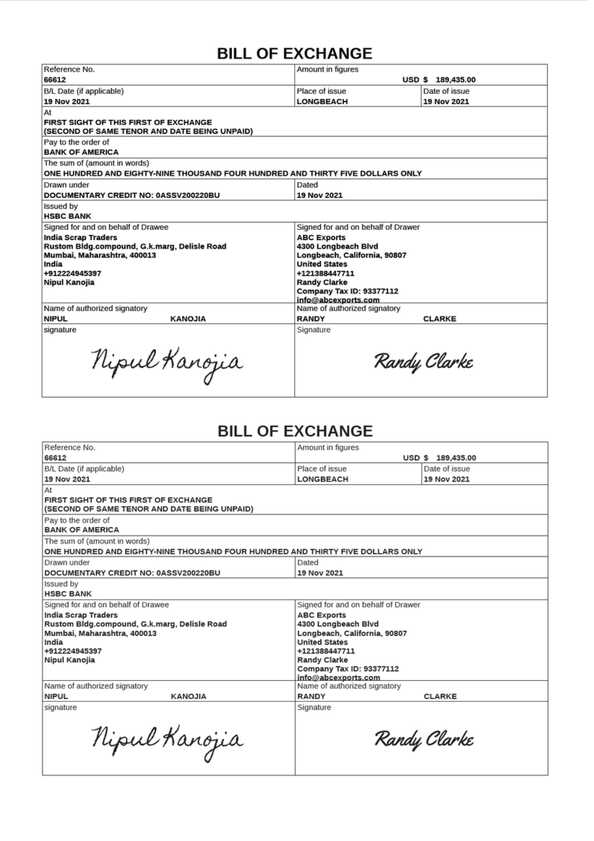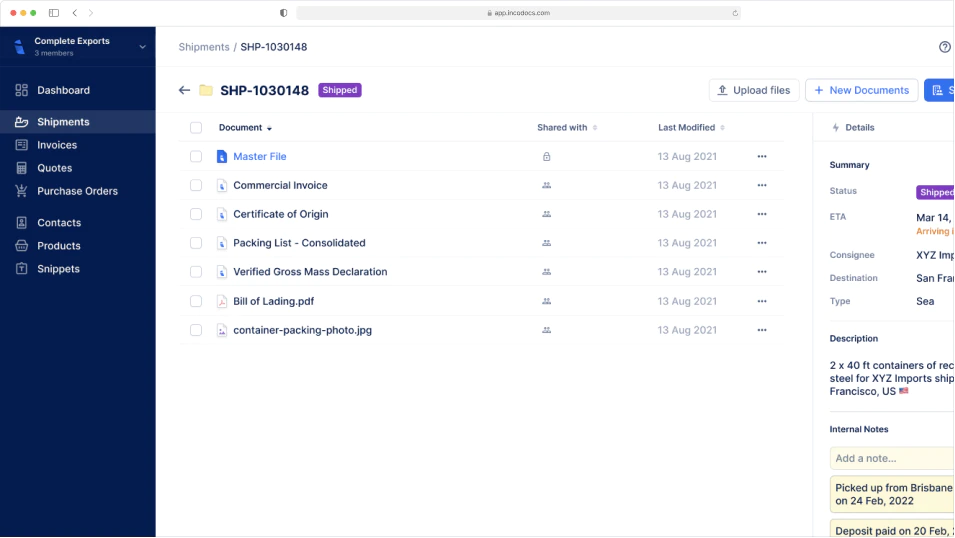IncoDocs raises $1.2M seed round led by Maersk GrowthRead the announcement

Bill of Exchange Template
What is a Bill of Exchange used for?
A Bill of Exchange is used primarily in international trade to request payment from buyers across borders. It gives exporters a way to collect funds for goods or services and may help them receive early payment when discounted through a financial institution. While it is not a contract, the bill acts as a written document that records payment terms agreed by the buyer and seller. These terms often include the amount, maturity date, interest charges, and credit period. The bill is a negotiable financial instrument that can be transferred to others or presented to a bank for payment. Under the Bills of Exchange Act 1882, the bill is defined as an unconditional written order, signed by one party and directing the drawee to pay a fixed sum of money to a third party, either on demand or at a specified future date. The drawee may be the importer or their bank. Once goods are shipped, the exporter draws the bill and submits it to their bank along with shipping papers like the Bill of Lading. The remitting bank forwards the documents to the drawee’s bank, known as the collecting bank. The drawee’s bank then presents the bill to the buyer for acceptance or payment, depending on the agreed terms and conditions.
How to create a Bill of Exchange
Open IncoDocs
Open IncoDocs in your browser and navigate to the “Export Docs” section.
Choose the Bill of Exchange template
Click on 'New document set' and select the Bill of Exchange template along with any other export documents you wish to create.
Fill out & customize your doc
Fill out the document, customize template fields to your needs and add your company letterhead. To save time and prevent re-entry errors, enter key shipment data into the Master File to have it sync across all other documents in your set automatically.
Sign & seal
Click on the signature box at the bottom of your document to create and place a digital signature then hit “Save & Quit”. On the document preview screen, click on the ‘More’ dropdown button and select “Add company seal” to place a digital stamp.
Download or share
Download or share documents from IncoDocs in 1-click. Documents can be downloaded as PDF or CSV which can be imported into other systems without manual re-entry.
Your questions, answered.
How does a Bill of Exchange work?
A Bill of Exchange is issued by the exporter to request payment from the importer. Once the goods are shipped, the exporter draws the bill and submits it with supporting documents to their bank. These are then sent to the importer’s bank.
The importer’s bank will present the Bill of Exchange to the buyer for acceptance or payment, depending on the agreed credit terms. Once the buyer accepts the bill, they become legally bound to pay the specified amount on the agreed date or upon presentation.
Who accepts a Bill of Exchange?
The Bill of Exchange is accepted by the drawee, who is usually the importer or their bank. Acceptance means the drawee agrees to the obligation to pay the amount written on the bill. Some bills are accepted for payment on demand, while others are paid on a specified date.
What are the different types of Bills of Exchange used?
There are several types of Bills of Exchange that are used:
The exporter may allow the funds to be paid at a later date (after the importer has received the goods) to give the importer more time to receive the goods before making the payment.
What is ‘Documents Against Acceptance’ and ‘Documents Against Payment’?
If the importer receives the shipping documents on ‘acceptance’ of the Bill, this is called Documents Against Acceptance. If the importer receives the shipping documents after payment has been made, this is called Documents Against Payment.
Once the buyer has accepted or paid the Bill, the collecting bank will release the shipping documents and the original Bill of Lading, which allows the importer to obtain ownership of the cargo. If the collecting bank releases the shipping documents to the buyer without received acceptance or payment from the buyer then the bank will become liable.
How is a Bill of Exchange different from promissory note?
A Bill of Exchange and a Promissory Note might seem similar, but they have important differences. A Bill of Exchange is issued by the seller (creditor) and orders the buyer (debtor) to pay a specific amount. It usually involves three parties: the drawer (seller), the drawee (buyer), and the payee (who receives the payment, often the seller). Bills of Exchange are common in international trade to ensure payment for goods and services and can be endorsed to others, making them a flexible payment tool.
In contrast, a Promissory Note is issued by the buyer (debtor) and is a promise to pay a specific amount to the seller (creditor). It involves two parties: the maker (buyer) and the payee (seller). Promissory Notes are often used in loans and personal transactions and are generally not transferable; they stay between the original parties.
Key Differences:
How is a Bill of Exchange Different from a Check?
A check is a type of Bill of Exchange. However, there are key differences between the two. A check is always drawn on a bank and payable on demand. It is a simple order from the bank's customer to the bank to pay a specific amount to a person or entity. A Bill of Exchange, on the other hand, can be drawn on anyone, including a bank, and is not necessarily payable on demand. It requires acceptance from the drawee before payment can be made, which is not required for a check.
What information is included on a Bill of Exchange Document?
It’s important that enough detail is provided on the Bill of Exchange to avoid any issues or misunderstandings between all parties involved in the process.
The details to be included on a Bill of Exchange document:
Free to start,
Easy to use.
Setup in 5 mins.
